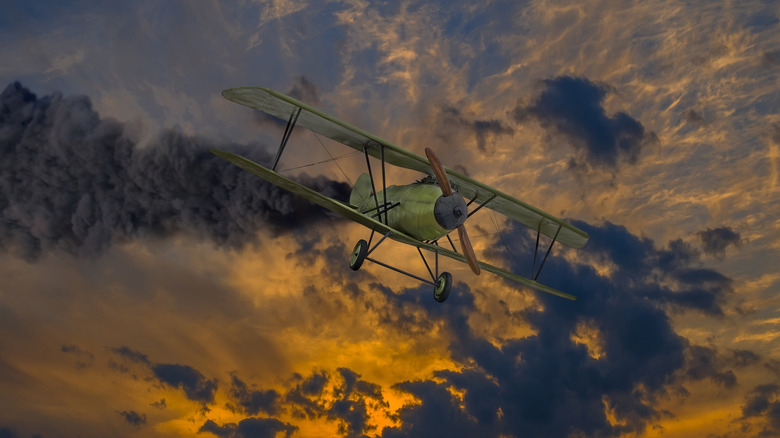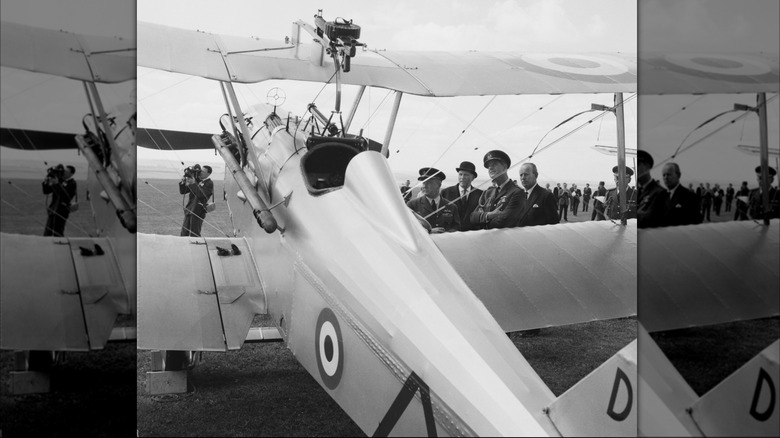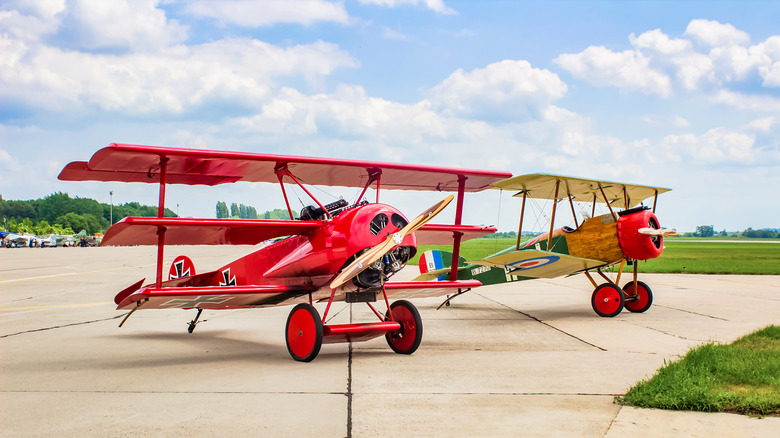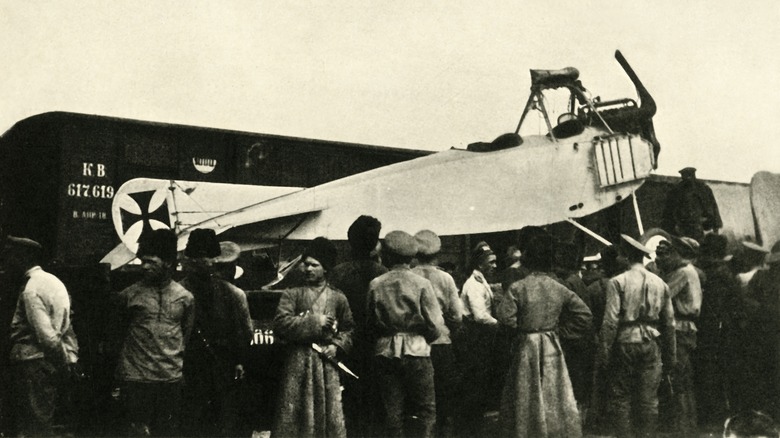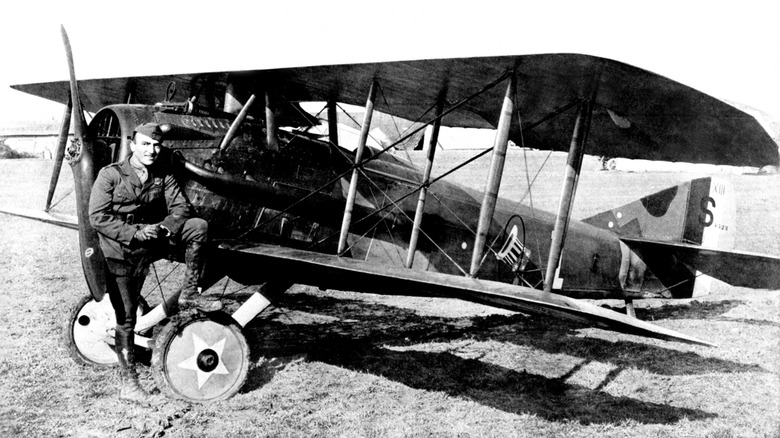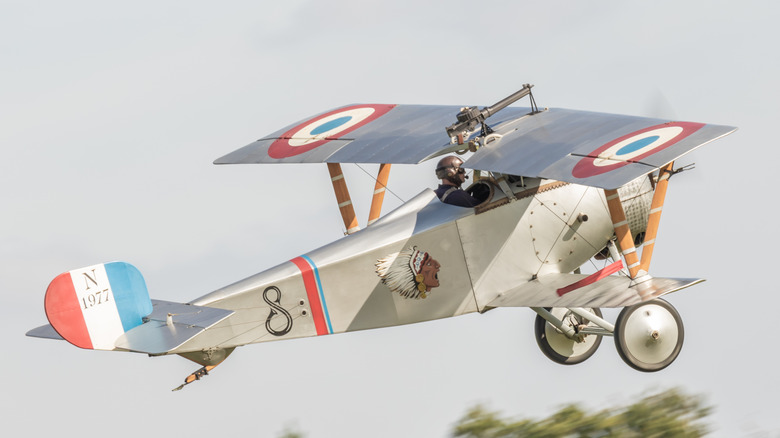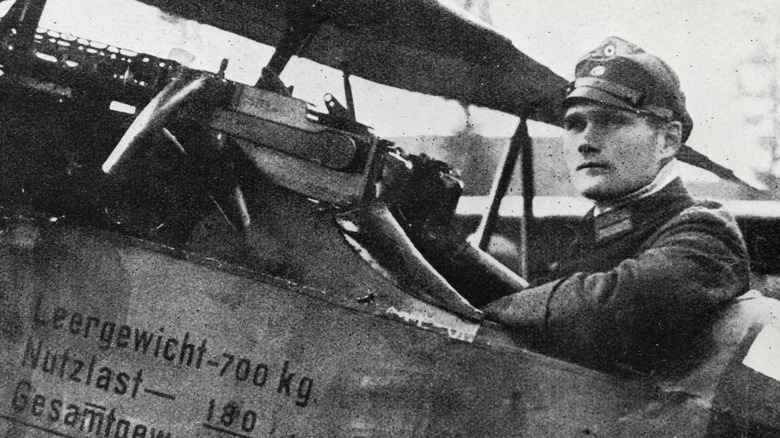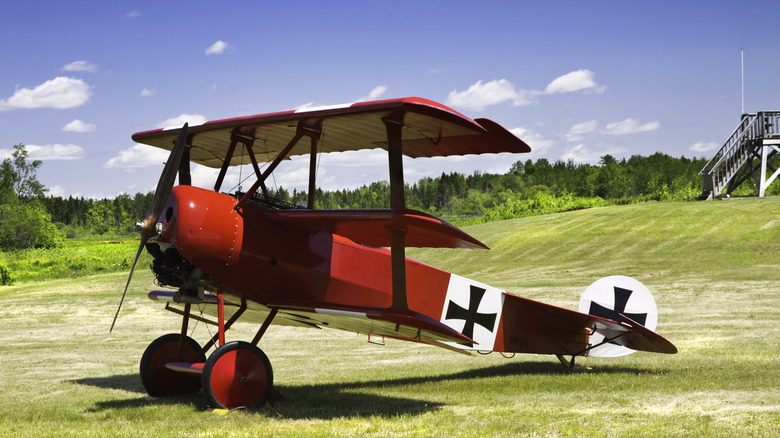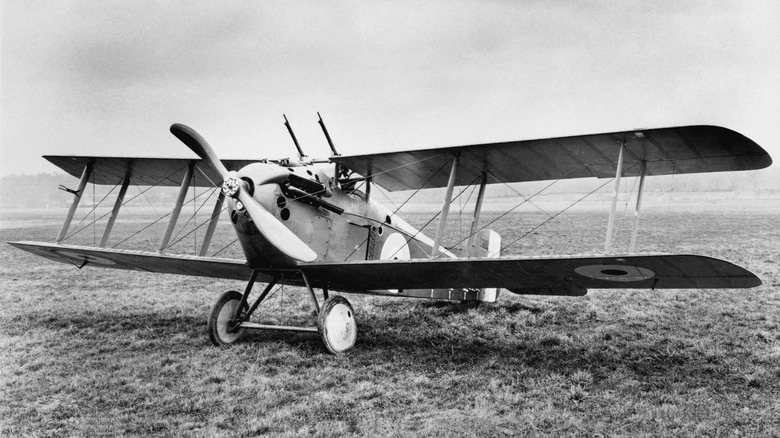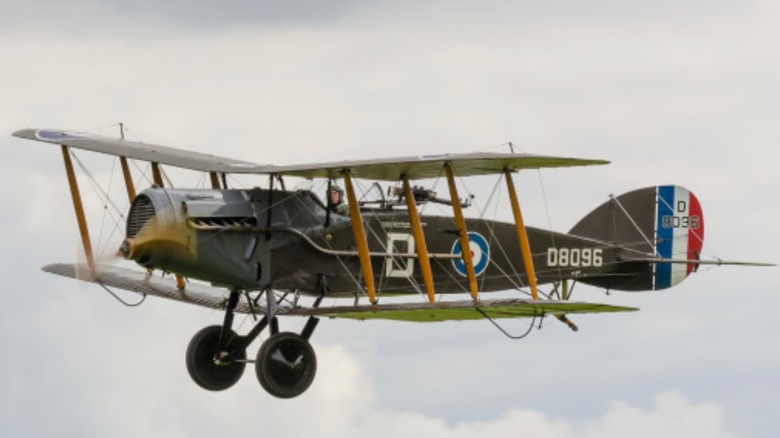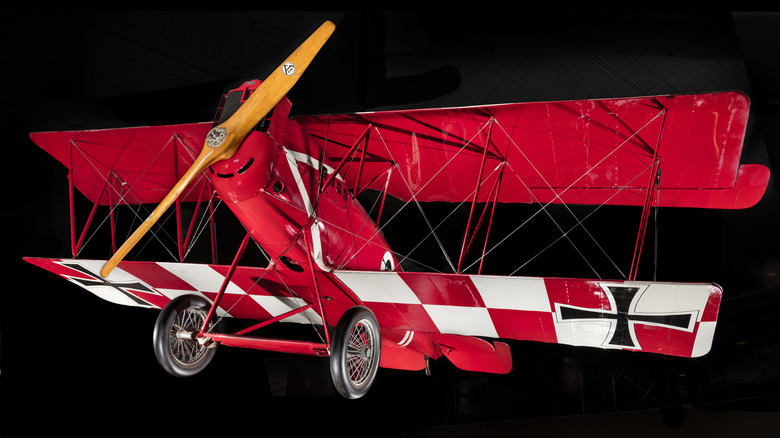10 Of The Top WWI Fighter Aircraft, Ranked
In the turbulent skies of the World War I era, innovation and bravery led to the birth of aerial combat, with both the Allies and the Central Powers vying for dominance in an uncharted battlespace. This era saw the creation of aircraft that were as varied and visionary as the aces who flew them, each leaving an indelible mark on aviation history.
The Sopwith Camel is known for its agility and many victories, while the Bristol F.2 Fighter remains a symbol of versatility and firepower; these machines were at the heart of the Great War. Germany showed its engineering mastery in the sleek designs of the Fokker Dr.I, flown by the legendary Red Baron, and the Albatros series, which combined deadly efficiency with high-altitude superiority. The SPAD S.XIII, France's dependable warhorse, flew through the skies matching the German aircraft in speed and outstripping them in terms of durability.
Amidst these titans, the Sopwith Dolphin appeared as a latecomer that startled both sides alike with its unconventional design and armaments. Though their time in the air was often brutally short, these aircraft and their pilots shaped the very nature of aerial warfare, setting precedents for generations to come. Here are some of the top fighter aircraft of WWI, ranked, paying homage to the groundbreaking designs and fearless spirit that defined the world's first dogfighters.
SE.5a
The SE.5a was one of the United Kingdom's best single-seat fighter aircraft, with its designation denoting "Scout Experimental." Initially, the SE.5 was powered by a 150 HP engine, but this was later upgraded to a 200 HP Wolseley V-8, leading to its SE.5a classification. The aircraft was the brainchild of John Kenworthy, Henry Folland, and Frank Goodden, and crafted in a Farnborough facility.
In terms of armament, the SE.5a had a mounted forward-facing 7.7mm gun, synchronized to fire through the propellers, and an additional Lewis Machine Gun mounted atop the wing. Furthermore, it had the capability to carry a few small bombs for targeted bombing missions.
In 1917, the SE.5a played a pivotal role in shifting air superiority from Germany. It was intentionally designed to be user-friendly for novice pilots, a strategic decision considering the tragically short life expectancy of World War I combatants. This design ensured that even inexperienced pilots could be effective in combat, reducing the reliance on seasoned aces.
While the SE.5a might not have been the fastest or most agile aircraft of the war, its blend of user-friendliness and versatile mission capabilities marked it as one of the era's standout planes. From its experimental origins, production soared, with over 5,000 units serving in the war's last two years.
Sopwith Camel
Sopwith Camel fighter planes could be found in Allied airbases all across the various fronts of World War I. Originating from the UK's Sopwith Aviation Company, this single-seat biplane featured twin .303-inch forward-facing guns, synchronized to fire through its propeller, a technological advancement that enabled direct, forward assaults.
The Sopwith Camel carved its name into military history by eliminating 1,294 enemy aircraft, a feat unmatched by any other fighter during the war. It was an imposing force in aerial combat, with a top speed of around 115 mph and exceptional agility. However, its power came with a steep learning curve. The aircraft's advanced engine delivered high velocity but demanded continuous pilot engagement with both rudders and control stick to maintain stability. In the absence of relentless control, the plane was prone to perilous spirals, making it a challenge reserved for the most skilled aviators. This difficulty in handling inadvertently birthed a new class of elite 'ace' pilots.
In the present day, a mere eight Sopwith Camels survive, preserved as revered relics of aviation history within museums across Europe and the United States.
Albatros D.III
The Albatros D.III, produced by Albatros Flugzeugwerke GmbH, was the third iteration in the Albatros series of fighter planes. This model introduced several enhancements over its predecessors and underwent further refinements during its operational service.
While the D.I was recognized as a reliable fighter, the D.II brought improvements in wing placement, cooling systems, and maneuverability. The D.III took these advancements further by adding V struts between its biplane wings, enhancing stability during flight maneuvers. Additionally, modifications to its Mercedes engine allowed it to operate effectively at higher altitudes, giving the D.III a distinct edge. The repositioning of the wings also improved pilot visibility.
The Albatros D.III was a biplane, built and used by Germany. For a time, it reigned supreme as one of the best fighter planes in the sky, but throughout World War I, technology rapidly advanced and improvements to technology quickly made models obsolete. It continued to be used until the end of the war, despite advancements made in newer models.
The Albatros D.III, like its series predecessors, was renowned for its combat capabilities. Armed with two synchronized Spandau 7.92mm guns, it could fire directly ahead without damaging its propeller. Esteemed ace pilots, including Kurt Wolff and the legendary Manfred von Richthofen, piloted the D.III during its tenure.
SPAD S.XIII
In 1917, the battle for air dominance was in constant flux. In March of that year, the SPAD S.XIII made its inaugural flight and quickly became a common sight in the skies, serving until the end of World War I. Manufactured by Société Pour L'Aviation et ses Dérivés (SPAD), the S.XIII was one of France's most reliable fighter aircraft.
The S.XIII was designed as an upgrade to its predecessor, the SPAD VII. While keeping the foundational structure, it was equipped with a more powerful V-8 Hispano-Suiza engine and boasted an expanded size and wingspan.
This enhanced power allowed the S.XIII to excel in climbing quickly. It was armed with two 7.7mm machine guns, positioned forward and synchronized with the propeller blades. When compared to the other aircraft making their debut in 1917, the S.XIII outpaced its German counterparts and matched the power of the Sopwith Camel. Its strength in combat, withstanding multiple machine gun hits before requiring repairs, made many pilots love it. Among its notable aviators was the American ace, Eddie Rickenbacker, who frequently piloted the S.XIII, alongside other aircraft, during the war.
Nieuport 17
The Nieuport 17 is one of the most famous plane designs to come out of the Société Anonyme des Établissement Nieuport. Introduced in 1915, by 1916 it was actively deployed across French, British, Italian, Belgian, and American fighter squadrons.
Powered by a 110-hp Le Rhône rotary engine, the Nieuport 17 was designed with a balanced blend of speed and agility. Its design incorporated a "V" strut between the wings, enhancing stability and durability during aerial maneuvers. Uniquely, it was a sesquiplane, featuring a full-sized upper wing and a smaller lower wing, which reduced drag and improved pilot visibility.
Initially, the aircraft was armed with a wing-mounted Lewis machine gun. As the war progressed, this was swapped out for a 7.7mm Vickers machine gun, synchronized with the propeller for forward firing.
The Nieuport 17 was so successful that Imperial Germany captured one of the planes and attempted to copy its design by building a replica based on the wreckage of the captured plane.
Fokker D.VII
In the latter stages of World War I, the Fokker D.VII restored Germany's dominance in the skies. The balance of aerial power tilted in 1917 when the Allies introduced a slew of advanced aircraft to challenge German supremacy. To counteract this, Germany initiated a design contest. By 1918, Fokker-Flugzeugwerke, led by Reinhold Platz and his design team, won the contest with their groundbreaking D.VII, swinging the pendulum of air superiority back to Germany.
The D.VII was a new concept biplane configuration, whose true innovation lay in its construction. It was among the first aircraft to employ a metal-welded frame, a departure from the predominantly wooden structures of the era. This metallic framework, combined with its aerodynamic efficiency, gave the D.VII outstanding agility, quick maneuverability, superior climb rates, and an increased operational ceiling. Making use of war industrialization policies, Germany was able to mass-produce the D.VII swiftly, making it a dangerous foe for the Allies.
The D.VII was so efficient and capable in the skies that it was specifically mentioned in the Treaty of Versailles. The treaty explicitly mandated Germany to hand over all D.VII units to the Allies and prohibited any further production. Consequently, the D.VII found its way into the air forces of various nations worldwide.
Fokker Dr.I
The Fokker Dr.I, a German-engineered triplane, is inherently linked to its most famous pilot, Manfred Von Richthofen, better known as the Red Baron. This aircraft stands out as one of World War I's premier dogfighters, celebrated for its unrivaled agility and maneuverability. It served with distinction until it was replaced by the Fokker Dr.VII.
Equipped with two 7.92mm Spandau light machine guns, the Fokker Dr.I wasn't the fastest aircraft of its time, reaching speeds of around 103 mph, with an operational range of 185 miles. However, its tri-wing design and superior rudder control enabled rapid climbs and swift turns. While Allied planes might have been faster along a straight line, the Fokker Dr.I's ability to quickly bank, dive, and climb provided a competitive edge in close-quarters combat.
Regrettably, no original Fokker Dr.I aircraft remain today; all were lost to the ravages of war or repurposed for their parts. Modern enthusiasts can only witness replicas, but the legacy of the Red Baron and the Fokker Dr.I ensures its place as one of World War I's most iconic aircraft.
Sopwith Dolphin
The Sopwith Dolphin was the Allies' late-stage addition to the aerial theater of World War I, making its debut in 1918. Its design was so distinct from its predecessors that it occasionally fell victim to friendly fire due to its unique appearance. It never gained as much popularity as the Sopwith Camel but, due to its operational abilities, it's one of the best World War I fighter planes.
The Dolphin was the first single-seat fighter to feature multiple gun mounts. Its arsenal included two forward-facing 7.7mm Vickers machine guns and an additional pair of Lewis machine guns on the top wing. This armament gave the Dolphin a firepower advantage over most contemporary fighters. Its wing design was also innovative: The lower wings were positioned ahead of the upper ones, improving the pilot's downward visibility. Additionally, the pilot's head emerged between the upper wings, further improving the field of view.
Although the Sopwith Dolphin's active service in World War I was brief, about 1,000 units were produced. These aircraft excelled as escorts and had a high survivability rate in dogfights, quickly dispelling any initial skepticism from pilots.
Post-war, the Dolphin continued to serve in various squadrons, but no new units were manufactured after the war's end.
Bristol F.2 Fighter
The Bristol F.2 Fighter is widely regarded in military history as World War I's best two-seater combat aircraft. Its design underwent several refinements until the definitive F.2A model debuted, including a powerful 190-horsepower engine and adopting a sesquiplane structure similar to the well-known Nieuport 17.
Armed for versatility and power, the F.2 Fighter featured two 7.7mm Vickers machine guns positioned forward and a flexible rear station for a gunner, equipped with either a single or double Lewis machine gun. This dual-directional firepower was unprecedented at the time, and the aircraft's capacity to carry a substantial bomb load further enhanced its strategic value.
However, the F.2 Fighter's initial flights were anything but successful, primarily due to flawed tactical approaches. Early combat strategies overemphasized the role of the rear gunner, with pilots instructed to prioritize the gunner's firing arc, neglecting the aircraft's inherent speed and maneuverability. This mistake resulted in severe losses. Once combat doctrine changed and the pilots reverted back to flying normally, the F.2 Fighter proved extremely capable. The fighter plane was able to utilize its full potential and the rear gunner was trained to take opportunity shots leading to higher mission success.
So despite its rocky start, the Bristol F.2 Fighter ultimately proved its worth and design philosophy, making it a powerful asset in the pursuit of aerial dominance during the Great War.
Pfalz D.III
Introduced in late 1917, the Pfalz D.III was among Germany's final aircraft models before World War I concluded. Despite its late entry, production surged in 1918, resulting in approximately 1,000 units built and deployed during the war's last year.
The subsequent Pfalz D.IIIa variant refined the original design. Initially, its twin 7.92mm Spandau machine guns were integrated into the fuselage, giving the aircraft a menacing look. However, for the D.IIIa, these were repositioned due to maintenance challenges. The in-fuselage guns frequently jammed and were tricky to service, limiting the plane's combat efficiency.
While the Pfalz D.III performed adequately in combat performance, the D.IIIa's enhancements fixed its predecessor's mechanical shortcomings. A standout feature was its exceptional diving capability. The D.IIIa could ascend higher than most aircraft at the time, enabling rapid dives for strikes — a tactic particularly effective against observation balloons. These balloons, typically protected by anti-aircraft artillery, were vulnerable to the D.IIIa's high-altitude dive attacks, which occurred beyond the artillery's effective range.
Although it only served for a short amount of time, the Pfalz D.IIIa proved to be an exceptional machine and an effective tool of war.
